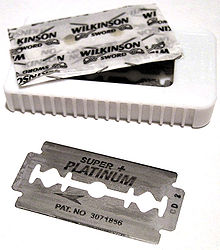razor blade
Razor originally referred to the blade of the razor . It is mainly used to cut (shave) the beard hair on the human face or to remove unwanted hair from other parts of the body ( legs , arms , intimate shaving in the pubic area ) by means of a wet shave .
description
Over time, the blade of the razor was developed into an independent component: King Camp Gillette invented a flat blade made of hardened steel in the 1890s , which was extremely thinned on both edges and therefore very sharp. It was used to insert into the safety razor specially developed for this purpose . The razor blade can be easily and inexpensively replaced with a new (sharp) one after it has worn out. The razor with interchangeable blade, the Shavette , represents a similar principle .
The manufacturers of razors for wet shaving meanwhile offer a variety of different carrier systems for razor blades and various blade combinations. There are interchangeable assemblies made of plastic on which up to six blades are attached parallel to each other and which are intended to increase the thoroughness of the shave . The market leaders in razors for wet shaving today are Gillette and Wilkinson Sword . The founder and namesake of the company King Camp Gillette is considered to be the inventor of the modern wet shave.
Also, electrical devices for dry shaving have been developed that have a completely different blade construction: razors .
Overview of common system razor blades
System razor blades are manufactured for a specific razor and are usually not compatible from system to system due to different holders. No single-use razors are shown.
| Surname | Manufacturer | specification | Inclusion / compatibility |
|---|---|---|---|
| Fusion power | Gillette | 5 single blades in one system | Clip-on |
| Mach3 | Gillette | 3 single blades in one system | Clip-on |
| Quattro | Wilkinson | 4 single blades in one system | Clip-on |
| Hydro 5 | Wilkinson | 5 single blades in one system | Clip-on |
| Protector 3 | Wilkinson | 3 single blades in one system | Clip-on |
| Classic | Wilkinson | Classic single blade for safety razors | Classic lid clamp |
| FX Diamond | Wilkinson | NN | Clamping |
| Original brown | brown | NN | NN |
Other uses
Individual, flat razor blade leaves were used in technical drawings and construction drawings in the time before the use of CAD to scrape off the drawing ink by scraping on the transparent drawing paper and thus making corrections.
There are special so-called razor blade scrapers to free hard, smooth and flat surfaces (for example glass or (cold) glass ceramic hob) from dirt by plane . The blade is guided not pulling, but pushing; with a sure instinct you can find a suitable angle (30 to 45 ° to the surface to be cleaned) and contact pressure in order to achieve effective cleaning. The fact that the ends of razor blades are suitably rounded and that trapezoidal blades have softer springs at their thin ends reduces the risk of scratching the glass surface with high pressure. As the temperature rises, glass and glass ceramic become softer than the hardened steel of blades and should therefore only be planed carefully at room temperature. Liquid slag droplets, such as those produced by machine grinding of iron (initially glowing), fuse with glass; if they are planed, they break out and leave a crater. The peeling with the rubber lip can then be done more effectively. Blades are only to be used when necessary for glass cleaning, as reflex (reducing) and other coatings are attacked. Wall paint, mortar splashes and chalk paint can be planed off after they have completely dried out, but wet calcium hydroxide chemically attacks glass. Blades can be used to plan on softer surfaces, such as plastic window frames, if the angle and contact pressure are reduced. Aluminum is soft compared to steel, but has a vulnerable, hard oxide layer which, however, must not be indented.
In optics , razor blades with their smooth edges (the cutting edges) are occasionally used to block (mask out) or also to scatter light. Stacks of razor blades can be used on the cutting edge as absorbers for medium-power lasers .
In biology , razor blades are often used to split sample material by pulling and cutting. In model making, balsa wood and thin cardboard are cut with a razor blade because they are thinner than narrow Stanley knife blades . To keep it safe, the razor blade can be half wrapped in paper. With special holders, you can cut passe-partouts with bevels along a ruler .
Web links
- Use of the razor blade sharpener , video from the Diepholz-Heede technology museum

